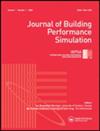采用基于人工神经网络的集总建模方法实现厂房的实时模型预测加热控制
IF 2.3
4区 工程技术
Q2 CONSTRUCTION & BUILDING TECHNOLOGY
引用次数: 0
摘要
在考虑室内环境的动态变化和不均匀分布的情况下,根据实时需求对供暖系统进行控制是非常重要的。本文提出了一种模型预测控制(MPC)方案,用于预测由大型不规则空间和发热设备组成的大型厂房室内多点空气温度。作者没有使用成熟的动态仿真模型(例如EnergyPlus),而是开发了一个集总仿真模型。该模型可以准确地预测温度,因此可用于厂房内61台加热器的最优开/关控制。基于MPC,在三周内实现了56.3%的节能,室内空气温度保持在舒适的范围内。文中着重指出,这种基于极简总集总模型的MPC方法能够准确预测室内热行为,节约大量能源。本文章由计算机程序翻译,如有差异,请以英文原文为准。
Implementation of real-time model predictive heating control for a factory building using ANN-based lumped modelling approach
ABSTRACT It is important to control the heating system by following real-time demand, while considering the dynamic changes and non-uniform distributions of indoor environments. This paper presents a model predictive control (MPC) scheme for predicting indoor air temperatures at multiple points in a large factory building that consists of large irregular spaces and heat-generating equipment. Instead of using a full-blown dynamic simulation model (e.g. EnergyPlus), the authors developed a lumped simulation model. This model can accurately predict the temperatures and is, therefore, used for the optimal on/off control of 61 unit heaters installed in the factory building. Based on the MPC, energy savings of 56.3% were realized over three weeks, and the indoor air temperatures were maintained within a comfortable range. It is highlighted in the paper that this MPC approach based on the minimalistic lumped model can accurately predict indoor thermal behaviour and save significant energy.
求助全文
通过发布文献求助,成功后即可免费获取论文全文。
去求助
来源期刊

Journal of Building Performance Simulation
CONSTRUCTION & BUILDING TECHNOLOGY-
CiteScore
5.50
自引率
12.00%
发文量
55
审稿时长
12 months
期刊介绍:
The Journal of Building Performance Simulation (JBPS) aims to make a substantial and lasting contribution to the international building community by supporting our authors and the high-quality, original research they submit. The journal also offers a forum for original review papers and researched case studies
We welcome building performance simulation contributions that explore the following topics related to buildings and communities:
-Theoretical aspects related to modelling and simulating the physical processes (thermal, air flow, moisture, lighting, acoustics).
-Theoretical aspects related to modelling and simulating conventional and innovative energy conversion, storage, distribution, and control systems.
-Theoretical aspects related to occupants, weather data, and other boundary conditions.
-Methods and algorithms for optimizing the performance of buildings and communities and the systems which service them, including interaction with the electrical grid.
-Uncertainty, sensitivity analysis, and calibration.
-Methods and algorithms for validating models and for verifying solution methods and tools.
-Development and validation of controls-oriented models that are appropriate for model predictive control and/or automated fault detection and diagnostics.
-Techniques for educating and training tool users.
-Software development techniques and interoperability issues with direct applicability to building performance simulation.
-Case studies involving the application of building performance simulation for any stage of the design, construction, commissioning, operation, or management of buildings and the systems which service them are welcomed if they include validation or aspects that make a novel contribution to the knowledge base.
 求助内容:
求助内容: 应助结果提醒方式:
应助结果提醒方式:


